Maidstone’s Motoring Pioneer, Jesse Ellis

By Pernille Richards, Collections Officer
November 2020
Past industries popularly associated with Maidstone are paper, brewing and confectionary production. It is perhaps less known that an enthusiastic player in the early days of road transport was based in Maidstone and had his engineering works in St Peter’s Street. Jesse Ellis (1846-1916) was an energetic character who was involved in an impressive range of business and for a while was at the forefront of the development and manufacture of steam wagons.
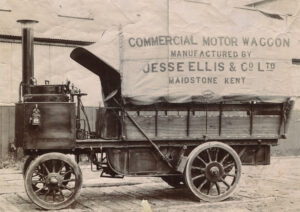
MMPR-Ellis-014 Jesse Ellis standing in front of an early 4 ton Motor Wagon produced by his works.
Jesse Ellis was born on the 14th of April 1846 in Cranbrook, the son of George Ellis a threshing and sawing contractor. His schooling was limited, but he is said to have had a gift for maths and grew up surrounded by agricultural machinery learning to drive a portable steam engine at an early age. Initially he worked for his father and at 18 he started working at the Thomas Aveling’s works in Rochester and at 23 he had become an independent threshing, sawing and haulage contractor. His works were in 23 Union Street where he lived with his wife. His works were in the yard, present day Starnes Court. Jesse and Mary Ellis were to have eight children and much of what we know about Jesse Ellis stems from the recollections of his daughter Mable White (born 1879) who later joined the business along with her brother Jesse Ellis Junior (born 1875) and sister May (born 1886). Research in the 1960s found that the records of the company no longer survived.
In 1873 Jesse Ellis went into a business partnership with Arthur Fremlin from Maidstone Brewery. It was a 25 year agreement to grow the business in Union Street. Unfortunately, Arthur Fremlin died three months after the agreement was signed, but his widow, Marianne Fremlin, continued the agreement. Jesse Ellis & Co undertook a wide variety of haulage work and contractual work related to agriculture, such as steam threshing, ploughing and sawing. Privately Jesse Ellis also had a forge and yard at London Road, Allington.
By 1880 Jesse Ellis was a wealthy business owner and prominent local resident. He was to suffer a considerable set back on the night between the 2/3 of December 1880, when one of his engines suffered a boiler explosion in Mill Street, Maidstone, killing one of its crew. Jesse Ellis held the contract for hauling manure through Maidstone. Hauling manure was a profitable business and he had several contracts hauling manure from London to farms in Kent. The transport of manure though Maidstone was limited to between midnight and 6 am so the load had to be moved at night. The crew of the Aveling & Porter locomotive, number 1302, who were to haul the content to a farm on the Sutton Road, were Moses Martin (driver), Frank Underwood (Steersman) and Harry Reader, who was a steam ploughing driver but acted as a flagsman on this evening. In Mill Street they stopped to relight a streetlamp, which had gone out, and when they started up again the engine exploded killing Frank Underwood and injuring the driver and steersman. The inquest which followed ruled that the reason for the explosion was due to a combination of a poorly repaired firebox and driving under excess pressure. The safety valves were also found not to have been working correctly. The inquest highlighted that there was a culture of long hours and a lack of focus on safety procedures at the works.
The incident had a profound effect on Jesse Ellis, who became focused on safer procedures and a champion for boiler inspection and insurance. In time he became first an associate and, in later life, a full member of the Institution of Mechanical Engineers. In 1885 Jesse Ellis and Marianne Fremlin moved the business premises to St Peter’s Street. The new site had previously been owned by John Tomlyn, a timber merchant. At two acres the new Invicta Works site had the workspace needed for improved maintenance and repair of boilers.
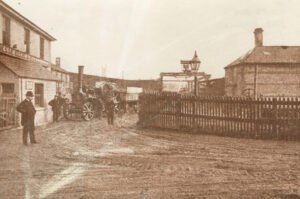
MMPR-ELLIS-007 The Jesse Ellis & Co Works
Business was booming. The demand for better road surfaces had steadily grown during the 1880s and from 1888 Kent County Council took over responsibility for the majority of roads and set about improving them. Jesse Ellis became a contractor working for the County Council making and repairing roads in Kent. Ever the entrepreneur he had a ragstone quarry at Boughton Monchelsea, which provided stone for his own contractor activities and income as he sold stone to other contractors. The Invicta Works site was perfect for this as it had river frontage and a dock, Sufferance Wharf, which were used to ship out stone as well as receiving other goods and the large quantities of coal used by the firm. In addition, he also imported Quassia timber, which was turned into a repellent for aphids on hop bines. As well as contractual work, the business supplied agricultural machines, sulphur, guano and stable manure to the agricultural community and with a rail line from the works to the South Eastern Railway network and a steam crane in the dock it was a modern and successful business.
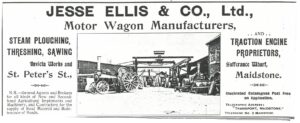
NO_ID23332 Advert from leaflet called Features of Historical Interests
Jesse Ellis was keenly interested in motorised vehicles. He was one of the founders of the Royal Automobile Club and lobbied for the passage of the Locomotive on Highways Act of 1896 which removed some of the strict rules and speed limits which had held back the adoptions of motorised vehicles in Britain. The agreement with Mrs Fremlin expired in 1896, but hopes were high for the development of steam wagons as a commercial venture, so they set up a limited liability company as a successor to the agreement. The establishment of the company and the showing of the first prototype steam wagon was delayed by the 1897 Typhoid Epidemic in Maidstone, but on the 4th of March 1898 Jesse Ellis & Co Ltd were created with many shareholders from the Maidstone and North Kent area.
The first vehicle to be developed was a Colonial Buck Wagon aimed at the South African market. In South Africa colonials relied on oxen for transport away from the railways, but in the 1890s a viral disease called Rinderpest, or sometimes bovine typhus, was widespread and causing severe problems. The wagon looked like a traditional Boer wagon but was made in steel with the boiler at the rear. It could be fired with solid or liquid fuel and carry its own water. It had a capacity for 50 miles of travelling. It was finished in December 1897 and demonstrated and reviewed in 1898, but it is unknown if it was ever sent to South Africa. A modified version of the original design was shown at the Royal Agricultural Society’s show at Birmingham in July 1898.
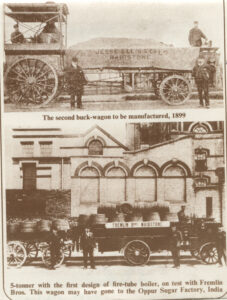
MMPR-Ellis-003 Second Buck wagon from 1899 and a 5 ton vehicle tested by Fremlin Bros.
Closer to home Jesse Ellis started developing a wagon suitable for transporting fruit. The railways transported the vast majority of the fruit grown in Kent to London and the growers were sometimes frustrated by the level of service. Jesse Ellis saw the competitive advantage in providing an alternative to the railways. The type developed had a load capacity of 2 tons and could go between 6 to 8 mph in low and high gear respectively. It proved a successful prototype and it was sold to Fremlin Bros in 1900 and in 1901 a new double framed wagon was patented (Patent no 11937). It was a successful type and was widely sold, especially to breweries, with examples bought by Style and Winch Ltd, but it was also bought by haulage companies and even Maidstone Corporation acquired one. It was a challenge to produce a steam wagon which was powerful and easy to drive, so there was a lot of experimentation with different types of boilers and gears in the process.
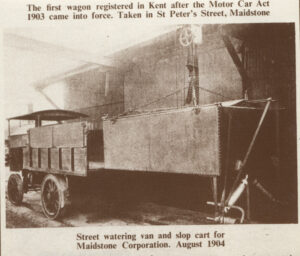
MMPR-ELLIS-006 Street Watering van and slop cart bought by Maidstone Corporation, 1904
Jesse Ellis junior went to Aswan as a junior engineer working for John Aird & Co in 1898 and this made Jesse Ellis senior interested in introducing steam wagons to Egypt and the Sudan. He made two trips, one on his own and a second visit with his daughter. ‘The Pictorial Record’, reported with enthusiasm:
“Mr. Jesse Ellis, managing director of the noted firm of road engineers and engineering contractors, is on the point of visiting Egypt with a motor transport waggon, specially built with the view of improving transport facilities at the present important juncture. In matters of road transport, probably no man living possesses so extensive an experience as Mr Ellis.”
In 1902 Jesse Ellis senior and his daughter Mable went to Egypt on a combined social and business trip. Jesse Ellis was a long term volunteer with the West Kent Yeomanry and in co-operation with one of his contacts he had developed a desert wagon for military use with a quick pitch canvas tent. The vehicle was demonstrated in Cairo, going up Citadel Hill, on Tuesday 2nd of December. The wagon was loaded with 3 tons of ballast and Jessie Ellis drove the wagon himself. The trial was a success and another trial took place in the desert near the Army barracks of Abbasieh where the regular wheels were changed for broader desert specification ones. It did a trial loaded with 41 soldiers and with the tent wagon coupled on. The wagon performed well on the road and firm ground but struggled with loose drifts of sand. Sir Reginald Wingate, Commander-in-Chief of the Army in Egypt, accepted the wagon after a favourable report of its performance, but no more orders were placed. An order for the Sanitary Department of Cairo was received from Sir Horace Pinchin, but the visit was more of a social success than a commercial one. Only seven of the wagons produced in the Ellis works were ever exported, the majority were sold and registered in Kent, which was fairly welcoming to steam transport. Not all areas were equally enthusiastic about steam transport on the roads. It was not without inconvenience and danger, many horses took fright at the blowing of steam, and there were some spectacular crashes as this accident at Boxley shows.
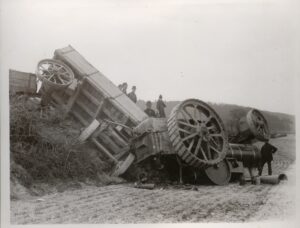
MMPR-Boxley-022 overturned vehicle Boxley
In 1905 a Heavy Motor car order came into force, which limited heavy vehicles to 5 tons. This meant that the double frame wagons previously developed by the Ellis works were too heavy and new types of vehicles had to be developed. Boiler types and gearing arrangements were also under continuous development. The Ellis works turned out wagons, slop carts, watering wagons, tipper trucks and even a steam bus, each vehicle had some modification or novelty in its construction. The continual design developments were expensive and despite Jesse Ellis’ considerable salesmanship, not recuperated in sales.
The company started to feel the pinch after Kent County Council set up its own road department in 1904 and the lucrative road contracting work was lost. Competition in rolling hire, agricultural threshing and ploughing work was fierce and the company no longer had the finance to continue developing vehicles. In 1906 the value of the company’s shares was written down and confidence in the company did not return. On the 30th of April 1907 the company went into receivership and assets were sold off. The Invicta Works site was let out by the receivers until it was sold on the 7th of October 1912, when the site was bought by Edward Sharp, who built his factory there as part of the expansion of his successful confectionary business. The majority of the Ellis works buildings disappeared in the process.
A number of long term employees transferred to working for Jesse Ellis in the Allington business, where he continued working in partnership with R. D Crosby as a roller owner and agricultural contractor, this company was also given the name Invicta Works.
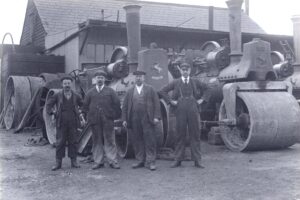
MMPR-ELLIS-011 Workmen outside Allington Forge, later the forge of William Humphrey.
The company continued in operation until 1910 when it was dissolved, and the plant sold at auction. Jesse Ellis continued working for another year, but by 1911 his health had deteriorated markedly, and he died on the 17 of October 1916.
He was a remarkable man, full of energy and vision and active in many fields. None of his engines are known to have survived and the buildings and company papers also appear to have been lost to history, so we are very fortunate to have photographs and research documenting this Maidstone business.
Sources.
Whitehead, Bob, ‘Jesse Ellis’, Old Motor, April 1967 ( NO_ID23331 Museum Ephemera collection)
Whitehead, R A, Jesse Ellis and the Maidstone Wagons, An account of a pioneer builder of steam road wagons, Tonbridge, Kent 1992
NO_ID23332, ‘Features of Historical Interest’ Museum Ephemera collection
Grace’s Guide, https://www.gracesguide.co.uk/Special:Search?search=jesse+ellis&fulltext=
Accessed 10 August 2020
Jesse Ellis, Wagons of Maidstone, History of Jesse Ellis, http://wagons.ellisonline.co.uk/history-of-jesse-ellis/ Accessed 10 August 2020. (Family history website)
